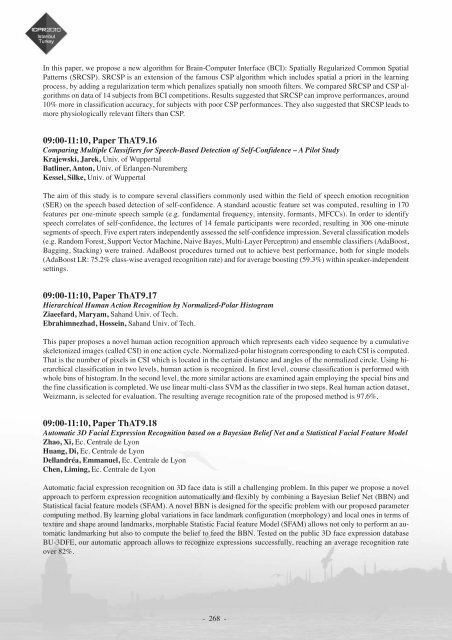Abstract book (pdf) - ICPR 2010
Abstract book (pdf) - ICPR 2010
Abstract book (pdf) - ICPR 2010
- TAGS
- abstract
- icpr
- icpr2010.org
You also want an ePaper? Increase the reach of your titles
YUMPU automatically turns print PDFs into web optimized ePapers that Google loves.
In this paper, we propose a new algorithm for Brain-Computer Interface (BCI): Spatially Regularized Common Spatial<br />
Patterns (SRCSP). SRCSP is an extension of the famous CSP algorithm which includes spatial a priori in the learning<br />
process, by adding a regularization term which penalizes spatially non smooth filters. We compared SRCSP and CSP algorithms<br />
on data of 14 subjects from BCI competitions. Results suggested that SRCSP can improve performances, around<br />
10% more in classification accuracy, for subjects with poor CSP performances. They also suggested that SRCSP leads to<br />
more physiologically relevant filters than CSP.<br />
09:00-11:10, Paper ThAT9.16<br />
Comparing Multiple Classifiers for Speech-Based Detection of Self-Confidence – A Pilot Study<br />
Krajewski, Jarek, Univ. of Wuppertal<br />
Batliner, Anton, Univ. of Erlangen-Nuremberg<br />
Kessel, Silke, Univ. of Wuppertal<br />
The aim of this study is to compare several classifiers commonly used within the field of speech emotion recognition<br />
(SER) on the speech based detection of self-confidence. A standard acoustic feature set was computed, resulting in 170<br />
features per one-minute speech sample (e.g. fundamental frequency, intensity, formants, MFCCs). In order to identify<br />
speech correlates of self-confidence, the lectures of 14 female participants were recorded, resulting in 306 one-minute<br />
segments of speech. Five expert raters independently assessed the self-confidence impression. Several classification models<br />
(e.g. Random Forest, Support Vector Machine, Naive Bayes, Multi-Layer Perceptron) and ensemble classifiers (AdaBoost,<br />
Bagging, Stacking) were trained. AdaBoost procedures turned out to achieve best performance, both for single models<br />
(AdaBoost LR: 75.2% class-wise averaged recognition rate) and for average boosting (59.3%) within speaker-independent<br />
settings.<br />
09:00-11:10, Paper ThAT9.17<br />
Hierarchical Human Action Recognition by Normalized-Polar Histogram<br />
Ziaeefard, Maryam, Sahand Univ. of Tech.<br />
Ebrahimnezhad, Hossein, Sahand Univ. of Tech.<br />
This paper proposes a novel human action recognition approach which represents each video sequence by a cumulative<br />
skeletonized images (called CSI) in one action cycle. Normalized-polar histogram corresponding to each CSI is computed.<br />
That is the number of pixels in CSI which is located in the certain distance and angles of the normalized circle. Using hierarchical<br />
classification in two levels, human action is recognized. In first level, course classification is performed with<br />
whole bins of histogram. In the second level, the more similar actions are examined again employing the special bins and<br />
the fine classification is completed. We use linear multi-class SVM as the classifier in two steps. Real human action dataset,<br />
Weizmann, is selected for evaluation. The resulting average recognition rate of the proposed method is 97.6%.<br />
09:00-11:10, Paper ThAT9.18<br />
Automatic 3D Facial Expression Recognition based on a Bayesian Belief Net and a Statistical Facial Feature Model<br />
Zhao, Xi, Ec. Centrale de Lyon<br />
Huang, Di, Ec. Centrale de Lyon<br />
Dellandréa, Emmanuel, Ec. Centrale de Lyon<br />
Chen, Liming, Ec. Centrale de Lyon<br />
Automatic facial expression recognition on 3D face data is still a challenging problem. In this paper we propose a novel<br />
approach to perform expression recognition automatically and flexibly by combining a Bayesian Belief Net (BBN) and<br />
Statistical facial feature models (SFAM). A novel BBN is designed for the specific problem with our proposed parameter<br />
computing method. By learning global variations in face landmark configuration (morphology) and local ones in terms of<br />
texture and shape around landmarks, morphable Statistic Facial feature Model (SFAM) allows not only to perform an automatic<br />
landmarking but also to compute the belief to feed the BBN. Tested on the public 3D face expression database<br />
BU-3DFE, our automatic approach allows to recognize expressions successfully, reaching an average recognition rate<br />
over 82%.<br />
- 268 -



